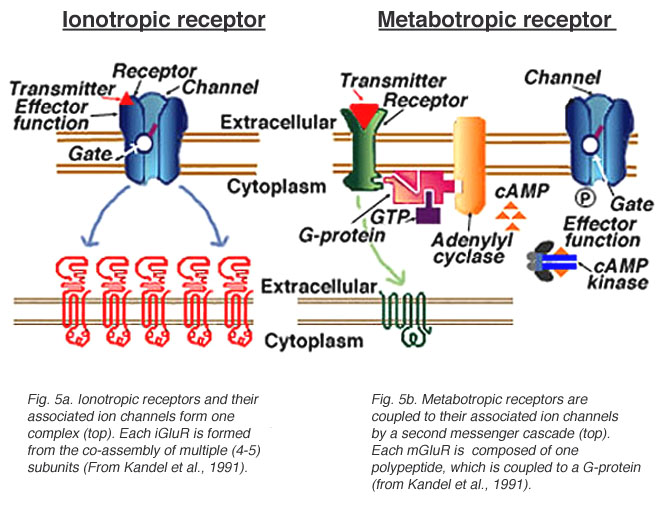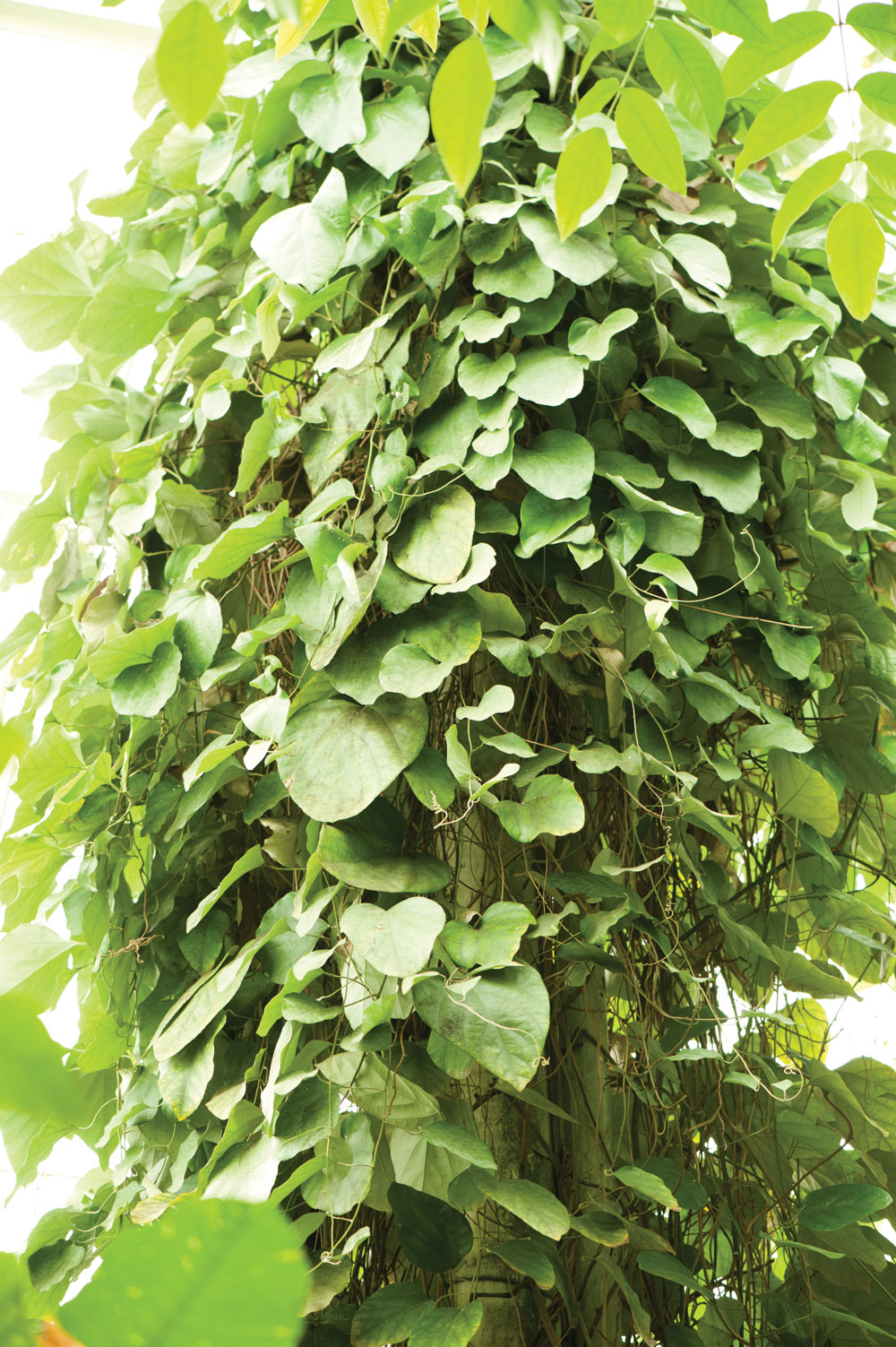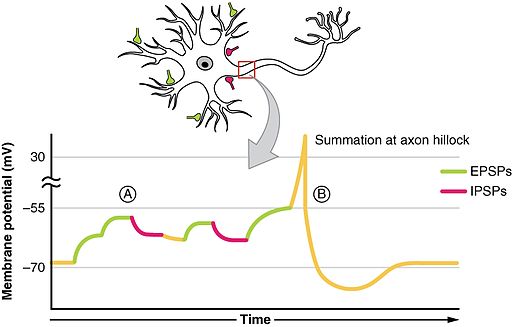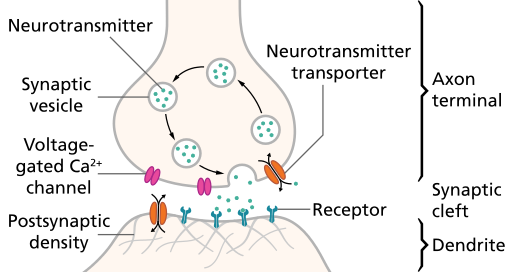- Neurochemistry
- How neurons talk to one another
- Synaptic communication
- Neurotransmitters
2017-09-24 11:46:50
Today's Topics
In the beginning
- Soma receives input from dendrites
- Axon hillock sums/integrates
- If sum > threshold, AP "fires"
Illustration of summation
Steps in synaptic transmission
- Rapid change in voltage triggers neurotransmitter (NT) release
- Voltage-gated calcium Ca++ channels open
- Ca++ causes synaptic vesicles to bind with presynaptic membrane, merge, exocytosis
Steps in synaptic transmission
- NTs diffuse across synaptic cleft
- NTs bind with receptors on postsynaptic membrane
- Receptors respond
- NTs unbind, are inactivated
Synaptic transmission
Excocytosis
Why do NTs move from presynaptic terminal toward postsynaptic cell?
- Electrostatic force pulls them
- Force of diffusion
Why do NTs move from presynaptic terminal toward postsynaptic cell?
- Electrostatic force pulls them
- Force of diffusion
Postsynaptic receptor types

Postsynaptic receptor types
- Ligand-gated ion channels
- Ionotropic (receptor + ion channel)
- Ligand-gated
- Open/close channel
- Faster, but short-acting effects
Postsynaptic receptor types
- Metabotropic (receptor only)
- Trigger 2nd messengers
- G-proteins
- Open/close adjacent channels, change metabolism
- Slower, but longer lasting effects
Receptor types

Receptors generate postsynaptic potentials (PSPs)
- Small voltage changes
- Amplitude scales with # of receptors activated
- Dendrites usually lack voltage gated Na+ channels
- Excitatory PSPs (EPSPs)
- Depolarize neuron (make more +)
- Inhibitory (IPSPs)
- Hyperpolarize neuron (make more -)
NTs inactivated
- Buffering
- e.g., glutamate into astrocytes (Anderson and Swanson 2000)
- Reuptake via transporters
- molecules in membrane that move NTs inside
- e.g., serotonin via serotonin transporter (SERT)
- Enzymatic degradation
- e.g., acetylcholinesterase (AChE) degrades acetylcholine (ACh)
Questions to ponder
- Why must NTs be inactivated?
Questions to ponder
- Why must NTs be inactivated?
- Keeps messages discrete, localized in time and space
- Maximizes concentration gradient
What sort of PSP would opening a Na+ channel produce?
- Excitatory PSP, Na+ flows in
- Excitatory PSP, Na+ flows out
- Inhibitory PSP, Na+ flows in
- Inhibitory PSP, Na+ flows out
What sort of PSP would opening a Na+ channel produce?
- Excitatory PSP, Na+ flows in
- Excitatory PSP, Na+ flows out
- Inhibitory PSP, Na+ flows in
- Inhibitory PSP, Na+ flows out
What sort of PSP would opening a Cl- channel produce?
Remember [Cl-out]>>[Cl-in]
- Excitatory PSP, Cl- flows in
- Excitatory PSP, Cl- flows out
- Inhibitory PSP, Cl- flows in
- Inhibitory PSP, Cl- flows out
What sort of PSP would opening a Cl- channel produce?
Remember [Cl-out]>>[Cl-in]
- Excitatory PSP, Cl- flows in
- Excitatory PSP, Cl- flows out
- Inhibitory PSP, Cl- flows in
- Inhibitory PSP, Cl- flows out
Types of synapses
Synapses on
- dendrites
- usually excitatory
- cell bodies
- usually inhibitory
- axons
- usually modulatory (change p(fire))
Summary of chemical transmission

Neurotransmiters
| Family | Neurotansmitter |
|---|---|
| Amino acids | Glutamate |
| \(\gamma\) aminobutyric acid (GABA) | |
| Glycine | |
| Aspartate |
Glutamate
- Primary excitatory NT in CNS
- Role in learning (via NMDA)
- Receptors on neurons and glia (astrocytes and oligodendrocytes)
- Linked to umami (savory) taste sensation, think MSG
- Dysregulation in schizophrenia? (Javitt 2010)
Glutamate
| Type | Receptor | Esp Permeable to |
|---|---|---|
| Ionotropic | AMPA | Na+, K+ |
| Kainate | ||
| NMDA | Ca+ | |
| Metabotropic | mGlu |
\(\gamma\) aminobutyric acid (GABA)
- Primary inhibitory NT in CNS
- Excitatory in developing CNS, [Cl-] in >> [Cl-] out
- Binding sites for benzodiazepines (e.g., Valium), barbiturates, ethanol, etc.
| Type | Receptor | Esp Permeable to |
|---|---|---|
| Ionotropic | GABA-A | Cl- |
| Metabotropic | GABA-B | K+ |
GABA

"GABAA-receptor-protein-example" by Chemgirl131 at English Wikipedia - Transferred from
en.wikipedia to Commons by Sreejithk2000 using CommonsHelper.. Licensed under Public Domain via Commons.
Other amino acid NTs
- Aspartate
- Like Glu, stimulates NMDA receptor
- Glycine
- Spinal cord interneurons
Acetylcholine (ACh)
- Primary excitatory NT of CNS output
- Somatic nervous system (motor neuron -> neuromuscular junction)
- Autonomic nervous system
- Sympathetic branch: preganglionic neuron
- Parasympathetic branch: pre/postganglionic
ACh anatomy
Acetylcholine
| Type | Receptor | Esp Permeable to | Blocked by |
|---|---|---|---|
| Ionotropic | Nicotinic (nAChR) | Na+, K+ | e.g., Curare |
| Metabotropic | Muscarinic (mAChR) | K+ | e.g., Atropine |
Curare

Atropine
- aka, nightshade or belladonna
References
Anderson, Christopher M., and Raymond A. Swanson. 2000. “Astrocyte Glutamate Transport: Review of Properties, Regulation, and Physiological Functions.” Glia 32 (1). John Wiley & Sons, Inc.: 1–14. doi:10.1002/1098-1136(200010)32:1<1::AID-GLIA10>3.0.CO;2-W.
Javitt, Daniel C. 2010. “Glutamatergic Theories of Schizophrenia.” Israel Journal of Psychiatry and Related Sciences 47 (1): 4.






